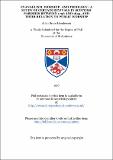Evangelism, worship, and theology : a study of certain revivals in Scottish parishes between 1796 and 1843, and their relation to public worship
Abstract
In Scottish Presbyterianism the period from 1796 to 184 3 was a transitional era of Evangelical ascendancy over Moderatism. Within that period, certain parishes had brief periods of evangelistic activities called 'revivals'. These movements were centered in services of public worship. The purpose of this thesis is to examine public worship during the era as a means of evangelism and to discern the processes by which the revivals took place. Public worship in Scotland during the eighteenth century has been commonly characterized as very ineffective, even barren. In both Moderate and Evangelical kirks, public worship was a preaching service with certain acts of devotion, but without a liturgy. From 1796 to 1843, public worship generally followed the traditions of the past, including the annual sacramental season. Although there were some stirrings toward a future renascence of worship, in such areas as published aids-to-worship, instrumental music, the singing of para-phrases and hymns, and more frequent Communion services, public worship continued to be a preaching service. Yet, in a few parishes, a season of revival did take place primarily within traditional, "weak" worship. The most unusual revival during the period of this study was the preaching tours by lay-preachers. Originated by J. A. Haldane, John Aikman, and Joseph Rate, this movement began as a plan for establishing religious schools in Highland parishes, and became an evangelistic organization called 'The Society for Propagating the Gospel at Home'. This organization not only was instrumental in brief awakenings in some parishes but also fostered certain discord in the state of religion in Scotland which resulted in official acts in Presbyterianism against lay-preaching. The S.P.G.H. ended in dissension from within in 1808. Even so, the evangelistic work of the S.P.G.H. did provide some notable revivals and a portion of the background for the revivals at Arran and Skye. Other revivals during the early nineteenth century were in parishes in the following places: Moulin (1796-1802), Arran (1812-13), Skye (1812-14), and Kilsyth (1839). The Kilsyth revival was the origin of a movement that spread to many other parishes in Scotland through 1841. Revival leaders were local parish ministers, with the exception of the Kilsyth movement which was led by a licentiate preacher, W. C. Burns, along with various local ministers. The revivals were centered in public worship services and prayer meetings. Sacramental seasons had no uniform place in each movement. Extemporaneous preaching within the general context of the traditional order of worship was the chief agent of awakenings. Generally, each brief season of revival also included a period of preparation characterised by expectation, a noticeable element of emotionalism, and results that were observable among certain individual lives more than those effecting parish life. The theology in the revivals was a portion of the Calvinism of the time which was directed at personal salvation. Conviction of total depravity, the covenant of grace which had conditional overtones, and limited atonement were the central doctrines of the theology in the revivals. The many detailed events in each revival parish gave each story an individuality apart from the other seasons of revival. And similarities noted among the various revivals did not uniquely distinguish them from many other contemporary parishes. Thus, in addition to that which can be discerned from the revivals of religion and their relation to public worship, the Church is reminded of her dependence upon the mysteries of God.
Type
Thesis, PhD Doctor of Philosophy
Collections
Items in the St Andrews Research Repository are protected by copyright, with all rights reserved, unless otherwise indicated.

